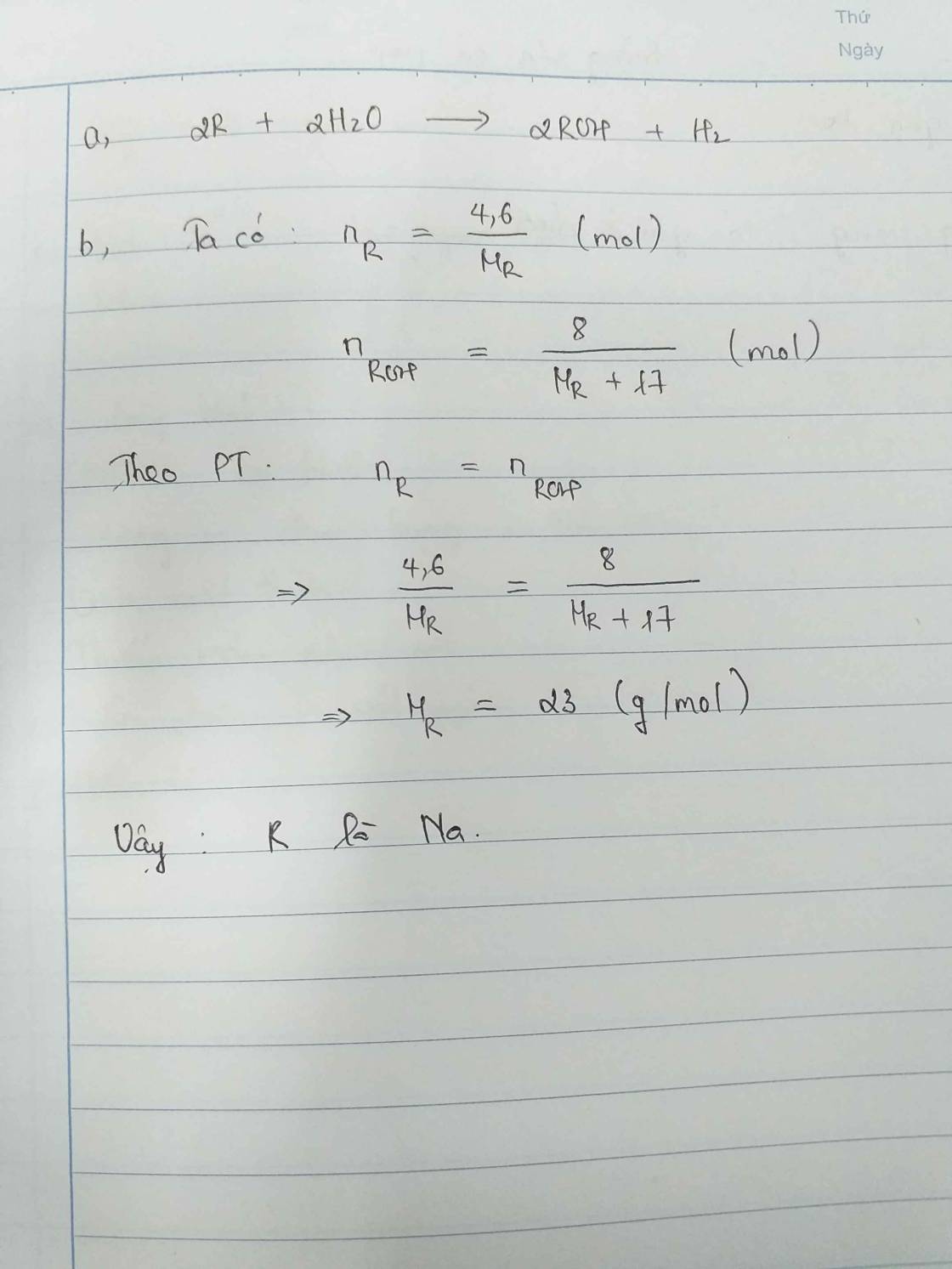Hãy nhập câu hỏi của bạn vào đây, nếu là tài khoản VIP, bạn sẽ được ưu tiên trả lời.

\(n_{A_2O}=\dfrac{9,4}{2M_A+16}\left(mol\right)\)
PTHH: A2O + 2HCl --> 2ACl + H2O
\(\dfrac{9,4}{2M_A+16}\)-->\(\dfrac{9,4}{M_A+8}\)
=> \(\dfrac{9,4}{M_A+8}\left(M_A+35,5\right)=14,9\Rightarrow M_A=39\left(g/mol\right)\)
=> A là K
CTHH: K2O

Bài 1:
\(n_M=\dfrac{16}{M_M}\left(mol\right)\)
PTHH: 2M + O2 --to--> 2MO
\(\dfrac{16}{M_M}\)---------->\(\dfrac{16}{M_M}\)
=> \(\dfrac{16}{M_M}\left(M_M+16\right)=20\)
=> MM = 64 (g/mol)
=> M là Cu
Bài 2:
\(n_R=\dfrac{16,2}{M_R}\left(mol\right)\)
PTHH: 2R + 3Cl2 --to--> 2RCl3
\(\dfrac{16,2}{M_R}\)------------>\(\dfrac{16,2}{M_R}\)
=> \(\dfrac{16,2}{M_R}\left(M_R+106,5\right)=80,1\)
=> MR = 27 (g/mol)
=> R là Al
1
ADDDLBTKL ta có
\(m_{O_2}=m_{MO}-m_M\\
m_{O_2}=20-16=4g\\
n_{O_2}=\dfrac{4}{32}=0,125\left(mol\right)\\
pthh:2M+O_2\underrightarrow{t^o}2MO\)
0,25 0,125
\(M_M=\dfrac{16}{0,25}=64\left(\dfrac{g}{mol}\right)\)
=> M là Cu
2
ADĐLBTKL ta có
\(m_{Cl_2}=m_{RCl_3}-m_R\\
m_{Cl_2}=80,1-16,2=63,9g\\
n_{Cl_2}=\dfrac{63,9}{71}=0,9\left(mol\right)\\
pthh:2R+3Cl_2\underrightarrow{t^o}2RCl_3\)
0,6 0,9
\(M_R=\dfrac{16,2}{0,6}=27\left(\dfrac{g}{mol}\right)\)
=> R là Al

Gọi công thức hóa học của oxit là RO
→Phương trình hóa học: RO+2HCl→RCl2+H2O
nRO:8,1\(R+16nRO)= nRCl2: 13,6\R+35,5.2
⇔ 8,1.(R+71)=13,6.(R+16)
⇔ 8,1R+575,1=13,6R+217,6
⇔ 8,1R−13,6R=−575,1+217,6
⇔ −5,5R=−357,5
⇔ R=65 (Zn)
→ R là nguyên tố Kẽm (Zn)
công thức hóa học: ZnO

PT: \(2R+O_2\underrightarrow{t^o}2RO\)
Ta có: \(n_R=\dfrac{13}{M_R}\left(mol\right)\), \(n_{RO}=\dfrac{16,2}{M_R+16}\left(mol\right)\)
Theo PT: \(n_R=n_{RO}\Rightarrow\dfrac{13}{M_R}=\dfrac{16,2}{M_R+16}\Rightarrow M_R=65\left(g/mol\right)\)
→ R là Kẽm (Zn).

Xin lỗi mấy bạn nha mình ghi lộn A B là hai kim loại có cùng hóa trị II

a/Ta có PTHH:
RO + 2HCl \(\rightarrow\) RCl2 + H2O
b) Mol RO = mol H2O = 0,05 mol.
\(\Rightarrow R+16=\dfrac{2,8}{0,05}=56\)
\(\Rightarrow R=56-16=40\)
Vậy nguyên tử R là Canxi (Ca)
https://hoc24.vn/hoi-dap/question/24299.html